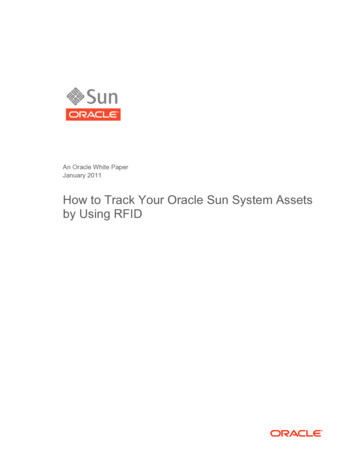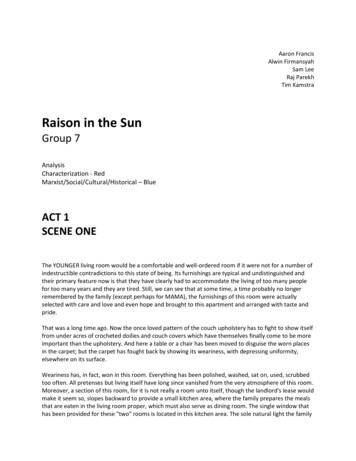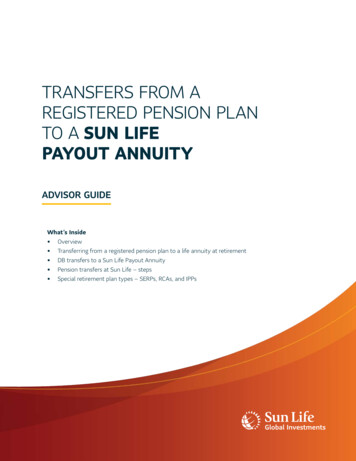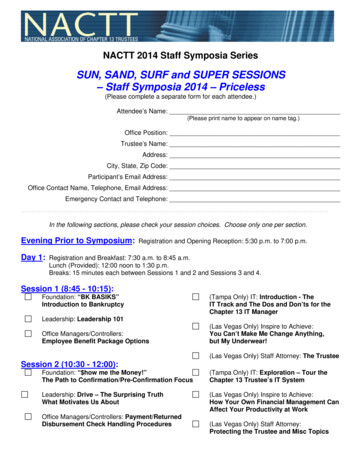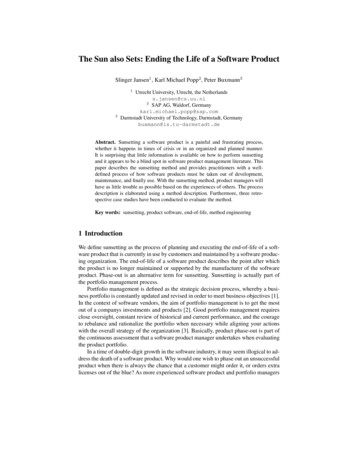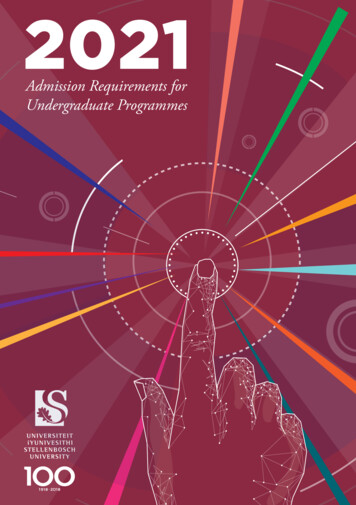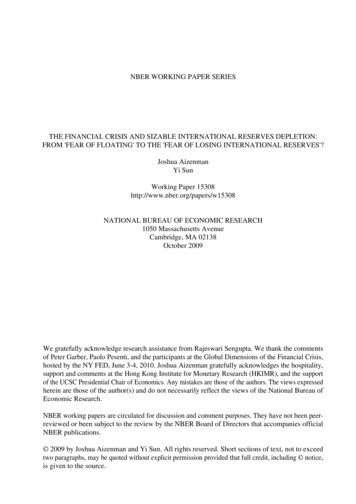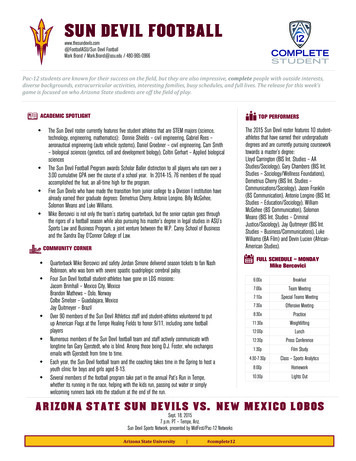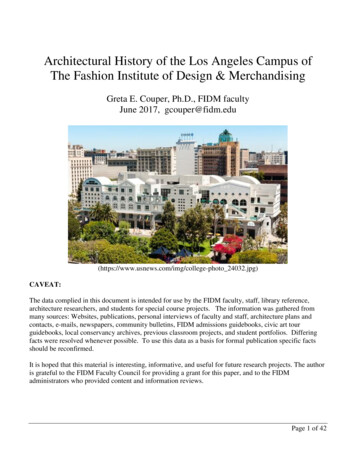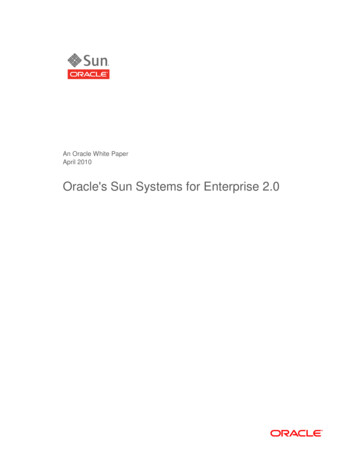
Transcription
An Oracle White PaperApril 2010Oracle's Sun Systems for Enterprise 2.0
Oracle White Paper— Oracle's Sun Systems for Enterprise 2.0Oracle's Sun Systems for Enterprise 2.0 .1Introduction .1Architecture .2System Components .3Software Stack .8Performance Characterization .10Test Environment .10Workload and Test Description.12Data Collection .13Test Results .13Results Summary .16Summary .17Appendix .18Preliminary Setup .18Load Balancer Configuration .18Database Server Installation.20Application/Oracle GlassFish Server .25Oracle WebLogic Server 10g Installation and Setup .27Tuning .39About the Authors.42References .42
Oracle White Paper— Oracle's Sun Systems for Enterprise 2.0Oracle's Sun Systems for Enterprise 2.0Improved business collaboration and easier information sharing within an enterprise can provide astrong competitive advantage. Enterprises today are seeking new communication technologies, such aswikis, blogs, and forums, to improve communication and collaboration and increase employeeproductivity. Oracle's Sun Systems for Enterprise 2.0 solution provides an integrated platform—combining highly scalable servers, next-generation storage, and networking technologies with best-ofbreed software and services from Oracle—to deploy a highly reliable Enterprise 2.0 infrastructure thatdelivers simplicity, speed, and savings.The following topics are addressed in this paper: “Introduction” on page 1 introduces the challenges and trends facing the enterprise today. “Architecture” on page 2 describes the architecture used by the Sun Systems for Enterprise 2.0 withOracle solution, including the hardware and software components. “Performance Characterization” on page 10 includes performance information that demonstratesscalability and can be used to help determine proper sizing of systems. “Appendix” on page 18 includes the procedures used to set up and configure the test environment.IntroductionInformation has expanded exponentially in recent years because of the new ways people are capturing,storing, and sharing information. This trend is apparent in social networks, and it is no different in theenterprise. Enterprise users seek to personalize the corporate intranet to their needs, share informationwith their peers, and easily update content without lengthy and cumbersome IT processes. In addition,employees want ways to be more productive, including single sign-on to the intranet and the variousapplications they use, an easy way to get information from one application and enter it in another, andincorporation of productivity tools such as calendars, time gadgets, and maps.The emergence of social networking—with new ways to communicate such as instant messaging, wikis,and blogging—is permeating the corporate world, and early adoption has shown very promisingresults. Users now expect a faster and more efficient way to communicate with peers, groups, andacross the enterprise. These new user requirements and trends are clear signs that there must bechanges to the existing corporate intranet. Welcome to the world of Enterprise 2.0.Web portals allow people to execute applications, process documents and other type of media, selfpublish content through blogs and wikis, and interact with peers through email, instant messaging, andother communication tools. Users access the portal through a common Web browser that iscustomized to their needs based upon their assigned roles, helping users find relevant information andapplications more easily.Planning an Enterprise 2.0 deployment takes time and technical knowledge on many disciplines.Selecting portal server software alone is not enough. Choosing hardware components such as servers1
Oracle White Paper— Oracle's Sun Systems for Enterprise 2.0and storage that can provide a solid foundation, and deploying the software infrastructure, includingdatabase, Web, and application server software, is equally important. This paper provides an answer foran Enterprise 2.0 architecture—a tested and proven solution that uses Oracle systems, OracleGlassFish Server, Oracle WebLogic Server, and the Oracle Database 11g with Real Application Cluster(RAC) Technology.ArchitectureThe Sun Systems for Enterprise 2.0 with Oracle solution combines key components in computing,storage, networking, and software into a comprehensive solution. This architecture, whichencompasses all needed components from the underlying hardware to the portal software, provides aflexible and adaptable implementation of highly available and scalable enterprise collaborationinitiatives, delivered through a Web-based portal interface.Major components of the Sun Systems for Enterprise 2.0 with Oracle solution include Oracle's SunBlade 6000 Modular System, with Sun Blade T6340 server modules and the Sun Blade 6000 VirtualizedMulti-Fabric 10 Gigabit Ethernet Network ExpressModule (NEM) from Oracle; Oracle's Sun Storage7000 Unified Storage Systems; the Oracle Solaris operating system; Oracle GlassFish Web SpaceServer; Oracle WebLogic Server; Oracle Database 11g with RAC; and Zeus Extensible Traffic Manager(ZXTM) load balancing software. A logical view of the system architecture, shown in Figure 1, depictsthe relationships between the various hardware and software components.Figure 1. Architectural logical diagram.2
Oracle White Paper— Oracle's Sun Systems for Enterprise 2.0System ComponentsTable 1 lists the specific hardware and software components included in the Sun Systems forEnterprise 2.0 with Oracle solution.TABLE 1. HARDWARE AND SOFTWARE COMPONENTSHardwareCOMPONENTPRODUCTServer hardwareSun Blade 6000 Modular system Sun Blade 6000 chassis Sun Blade T6340 server modules Sun Blade 6000 Virtualized Multi-Fabric 10 GbE NEMSoftwareStorageSun Storage 7410 SystemRackSun Rack IIOperating systemOracle Solaris SPARC OS 10, update 8Load balancerZeus Extensible Traffic ManagerPortalOracle GlassFish ServerWeb/ApplicationOracle WebLogic Server 10g Release 3DatabaseOracle Database 11g with RACHardware ComponentsThe primary hardware components include the Sun Blade 6000 Modular System, the Sun Storage 7410System, and the Sun Rack II.The Sun Blade 6000 Modular SystemThe Sun Blade 6000 Modular System provides the hardware foundation for this Enterprise 2.0solution. This modular, scalable system with a choice of blade server module options provides aflexible platform suitable for enterprise deployments. The system consists of the followingcomponents: Sun Blade 6000 chassis fits in a compact 10U form factor while supporting up to 10 full-featured bladeserver modules (see Figure 2). These server modules can be separately provisioned to run differentoperating systems such as Solaris OS, Linux or Windows. A key factor in selecting this chassis forthis solution is its standout I/O throughput. This chassis offers full throughput to every servermodule for all configurations, industry-standard ExpressModule slots, as well as added-valueNetwork ExpressModule (NEM) boards. In addition, the chassis’ modular architecture and hotswappable components help ensure optimal availability, serviceability, and ease of deployment.3
Oracle White Paper— Oracle's Sun Systems for Enterprise 2.0Figure 2. Sun Blade 6000 chassis. The Sun Blade T6340 Server Module, the highest density chip multithreading (CMT) server available ina blade form factor, delivers massive throughput and built-in, no-cost encryption and virtualization(Oracle VM Server for SPARC). The Sun Blade T6340 Server Module, equipped with two 1.4 GHzUltraSPARC T2 Plus processors, is one of the highest performing and most efficient platformsavailable. Published results on industry-standard benchmarks, including the fastest dual-processorresult on an enterprise Java workload, demonstrate the ability of the Sun Blade T6340 servermodule to handle enterprise-scale Java workloads. 1Figure 3. Sun Blade T6340 server module. The Sun Blade 6000 Virtualized Multi-Fabric 10 GbE Network ExpressModule (NEM) allows up to fivehosts to share a single 10 GbE network port with a dedicated PCIe endpoint for each host. Eachserver module appears to have its own 10 GbE NIC through virtualized NEM ASICs. With twovirtualized NEM ASICs connected through the Inter-ASIC Link (IAL), a single 10 GbE port can actas the shared I/O for 10 server modules.1 See e.xml for details on the Sun Blade T6340 servermodule performance on industry-standard benchmarks.4
Oracle White Paper— Oracle's Sun Systems for Enterprise 2.0Figure 4. Sun Blade 6000 Virtualized Multi-Fabric 10 GbE Network ExpressModuleThe Sun Blade 6000 Virtualized Multi-Fabric 10 GbE NEM provides many benefits to thissolution by reducing the cost of cabling and port management, simplifying deployment andreconfiguration, as well as eliminating the need for compatibility and interoperability issues withenterprise switches.In this solution, the Sun Blade 6000 chassis is configured with one Sun Blade 6000 VirtualizedMulti-Fabric 10 GbE NEM; a second NEM can offer redundancy and increased networkperformance, if required.Sun Storage 7410 SystemThe Sun Storage 7410 system, part of Sun Storage 7000 Unified Storage Systems product line, providesan ideal storage platform that fulfills enterprise requirements along with ease of management. Thestorage system consists of a controller with 64 GB RAM and dual quad-core processors, and a 12 TB(twelve 1 TB drives) storage array. In this solution, Oracle database files were created using the NFS v3data protocol.Sun Rack IIAll hardware components of this solution are installed into a Sun Rack II, Oracle's newest rack. Thisenclosure, optimized for vertical density, offers zero-RU power distribution units (PDU). The design,with PDUs installed on the rear side of the cabinet, enables supply of high amperage without taking upany usable space. The PDUs contain a metering unit that enables monitoring of the current being usedby the equipment connected to the PDU.Software ComponentsThe primary software components include Oracle Solaris OS, Oracle GlassFish Server, OracleWebLogic Server, Oracle Database 11g with RAC, and Zeus load balancing software.Oracle Solaris SPARC OS 10, update 8This latest version of Oracle’s enterprise-class operating system provides a rich, coherent platform forbuilding and running applications. Oracle Solaris includes support for Oracle Solaris Zettabyte FileSystem, an open-source 128-bit file system with built-in reliability and availability features; a highperformance networking stack for IPv4 or IPv6 networking; IP network multipathing to provide faulttolerance and load spreading for network interface cards (NICs); virtualization features such as OracleSolaris Containers and Oracle Solaris Zones; Dtrace Analytics, including capabilities that provideinstrumentation for real-time performance analysis and debugging; and Predictive Self-Healing5
Oracle White Paper— Oracle's Sun Systems for Enterprise 2.0technology that allows automatic diagnosis, isolation, and recovery from many hardware andapplication faults.Oracle GlassFish Web Space ServerOracle GlassFish Web Space Server, a new class of portal server, includes a comprehensive set ofcapabilities that enables organizations to provide users with personalized Web spaces that can be usedfor collaboration, business processes, communications, social networking, and much more. The OracleGlassFish Server leverages the open-source Liferay Portal project and provides the followingcapabilities that simplify collaboration and development of Web content: Content Management—Oracle GlassFish Server provides an extensive set of content managementcapabilities. A WYSIWYG Web editor simplifies content generation. Content staging functionalitycontrols content publishing by staging page content and assigning content managers. Multilevelcustom workflow allows more than one reviewer or approver of content, and helps facilitate thescheduling of new content publication. Document and file management and a variety of file hostingcapabilities—including user and community files, file check-in and check-out, Office Suiteintegration, versioning, tagging, search, and image and slide show viewing—are all supported. Collaboration—The collaboration tools included in the Oracle GlassFish Server enable easycollaboration within the enterprise and can be used to improve communication and the capture andsharing of intellectual property. Users have access to self-Web publishing capabilities such as wikis,blogs, and forums. Social networking and user-defined communities are also supported, allowinganyone to create a community to facilitate ad hoc productivity requirements. Security—Oracle GlassFish Server provides Web single sign-on (SSO) capabilities utilizing FederatedAccess Manager (FAM) for authentication and role management. WS-Federation and SecurityAssertion Markup Language (SAML) identity protocols are supported. Identity-based contentdelivery (IDBC) helps streamline business processes by directing the right content and applicationsto the right user, group, or role, to accelerate the search for relevant content. Productivity—Oracle GlassFish Server offers many features that improve productivity. A wiki server isincluded in the installation; users can aggregate existing social networks and perform self-Webpublishing of content. Widget and gadget integration allows the easy incorporation of productivitytools such as calendars, date and time gadgets, and maps. The Oracle GlassFish Server also includesa Simple API for Workflow (SAW) that provides a common API for integrating with rules engines.Oracle WebLogic Server 10, Release 3Oracle WebLogic Server 10, Release 3, is a scalable, enterprise-ready Java 2, Enterprise Edition (J2EE)application server. The Oracle WebLogic Server infrastructure supports the deployment of many typesof distributed applications and is an ideal foundation for building applications based on ServiceOriented Architecture (SOA). SOA is a design methodology aimed at maximizing the reuse ofapplication services.6
Oracle White Paper— Oracle's Sun Systems for Enterprise 2.0Oracle WebLogic Server, a complete implementation of the Sun Microsystems J2EE 5.0specification, provides a standard set of APIs for creating distributed Java applications that canaccess a wide variety of services, such as databases, messaging services, and connections to externalenterprise systems.Oracle Database 11g with RACOracle Database 11g with RAC is a clustered database designed for grid computing implementations. Aproven technology that allows multiple servers to perform as a single large server, Oracle Database 11gwith RAC forms a key foundation for enterprise database grids, providing the highest level of databaseavailability along with flexibility in scaling. If a node in the cluster fails, the Oracle software continuesrunning on the remaining nodes. If more processing power is necessary, new nodes can easily be addedto the cluster. Key benefits of the Oracle Database 11g with RAC include: Single system image management Automated workload management, including workload monitoring and resource management Fast connection failover and recovery Data integration for fast disaster recovery Cluster verification and diagnostic toolsNote: Sun Cluster Advanced Edition for Oracle RAC software can be used to manage the multiple servers configured in aclustered deployment. Designed to improve service availability, resource utilization, and scalability, the Sun Cluster AdvancedEdition for Oracle RAC software can also help accelerate disaster recovery and ease system management. In addition toproviding I/O fencing to help guarantee data integrity, this software is designed for tighter integration with the Solaris OS to helpminimize application downtime.Load BalancerZeus Extensible Traffic Manager (ZXTM) software from Zeus Technology is used for load balancinguser requests among the multiple Web and application servers. The benefits of using ZXTM as a loadbalancer include: Price/performance and flexible platform deployment choice TrafficScript and Java Extensions offer huge extensibility Clustered with distributed configuration SSL-Optimized for use of onboard cryptography with Sun CMT server platform.Note: It is possible to use a hardware load balancer, instead of software such as ZXTM. In both cases, the load balancer can beclustered with a second one for redundancy and to achieve a higher degree of availability.7
Oracle White Paper— Oracle's Sun Systems for Enterprise 2.0Software StackComponents of the software stack used by the Sun Systems for Enterprise 2.0 with Oracle solution aredepicted in Figure 5. The stack can be logically divided into two main groupings: the infrastructure andthe Oracle GlassFish Server.Note: TheOpenSSO/FAM8.0 componentis optional andwas not used totest this solutionFigure 5. Software stack.The Oracle GlassFish Server includes a container and desktop layer, plus components that generatecontent for the layout container. Container: The page container holds the header, navigation, tabs, and other “look and feel” items.The page container is rendered based on the theme definition and any defined portlets, which arehosted in the portlet container above. Other components, shown in the top row of Figure 5, generate content for the layout container.These include:Web Services for Remote Portlets (WSRP)—allows remote portlets to be hosted on the local page, andalso allows local portlets to be exposed (published) for inclusion on other Web properties and venues. Portlet container—holds all local portlets and manages their life cycles. Platform adapter—allows portlets written in different languages (such as PHP and Ruby) or otherwidgets from other platforms (such as jMaki and JavaFX) to be rendered locally as though they werelocal portlets. Generic content/portlet—represents all local or built-in portlets, such as wikis, blogs, andapplications.8
Oracle White Paper— Oracle's Sun Systems for Enterprise 2.0The infrastructure includes three primary components: identity authentication, application and Webserver, and database. Identity/Authentication—OpenSSO: Provides authentication services and mapping of LDAP usergroups and roles to the portal data model (such as communities and organizations). Application Server—Oracle WebLogic Server: Provides J2EE services and containment of theoverall portal application. This component enables clustering of portal applications and Web serviceinfrastructure for accessing
with RAC; and Zeus Extensible Traffic Manager (ZXTM) load balancing software. A logical view of the system architecture, shown in Figure 1, depicts the relationsh

